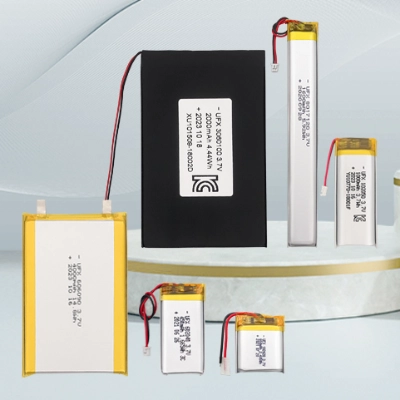What is the difference between a 3.6V and a 3.7V battery? Regarding lithium batteries, you may come across different voltage ratings, such as 3.6V and 3.7V. This article explores the critical differences between these two voltage ratings and sheds light on their implications for various applications. So, let’s begin.
Part 1. What is the nominal voltage of a lithium battery?
Common search terms like “3.6v vs 3.7v battery difference” or “can I use 3.7v instead of 3.6v” often stem from confusion around nominal voltage. Here’s a technical breakdown:
Let’s first grasp the voltage ratings in lithium batteries. Voltage refers to the electrical potential difference between two points in a circuit. In the case of lithium batteries, the voltage rating represents the nominal voltage or average voltage output of the battery during its discharge cycle. It is a crucial parameter in determining the battery’s compatibility with a specific device or system.
Part 2. Exploring the 3.6V lithium battery
The 3.6V lithium battery, also known as a 3.6V lithium-ion battery, is a common variant in many electronic devices. Many people widely use it for its reliable performance, stability, and compatibility with various applications. These batteries employ lithium-ion technology, which offers high energy density and low self-discharge rates.
Advantages of 3.6V Lithium Batteries
- Higher Energy Density: 3.6V lithium batteries often exhibit higher energy density than their counterparts with a higher nominal voltage. This means they can store more energy per unit volume, resulting in longer battery life or smaller battery sizes for a given capacity.
- Compatibility: Many electronic devices, especially those designed before the widespread adoption of 3.7V batteries, are optimized for 3.6V power sources. A 3.6V lithium battery ensures seamless compatibility and optimal performance in such devices.
- Lower Self-Discharge: 3.6V lithium batteries tend to have lower self-discharge rates, meaning they retain their charge for extended periods when not in use. This characteristic makes them suitable for applications where long shelf life is essential.
Limitations of 3.6V Lithium Batteries
- Voltage Sensitivity: Some electronic devices have strict voltage requirements, and deviations from the specified voltage range can lead to improper functioning or damage. As 3.6V batteries operate at a slightly lower voltage than 3.7V batteries, they may not be compatible with devices designed specifically for the latter.
- Availability: With the increasing popularity of 3.7V lithium batteries, finding 3.6V batteries might be more challenging in specific markets. This limited availability can constrain manufacturers and consumers who rely on 3.6V batteries for their devices.
Part 3. View 3.7V lithium battery
Let’s explore the 3.7V lithium battery, another commonly utilized variant in electronic devices. These batteries also employ lithium-ion technology and share similarities with their 3.6V counterparts. Still, there are some key differences worth noting.
Advantages of 3.7V Lithium Batteries
- Wider Compatibility: Many modern electronic devices, including smartphones, tablets, and laptops, are designed to work optimally with 3.7V lithium batteries. This nominal voltage rating’s ubiquity ensures easy availability and compatibility with a broad range of devices.
- Higher Voltage: 3.7V batteries’ slightly higher nominal voltage makes them suitable for devices that require a higher power supply. This higher voltage output can enhance such devices’ overall performance and responsiveness.
Limitations of 3.7V Lithium Batteries
- Lower Energy Density: Compared to 3.6V batteries, 3.7V batteries generally have a slightly lower energy density. This means they may offer somewhat shorter battery life or require a larger physical size to achieve similar capacity levels.
- Higher Self-Discharge: 3.7V lithium batteries tend to have higher self-discharge rates than their 3.6V counterparts. This characteristic can lead to a faster charge depletion when the battery is not in use, making them less suitable for applications that require extended storage periods without recharging.
Part 4. Difference between a 3.6V and a 3.7V battery
3.6V vs 3.7V Lithium Battery: Direct Comparison Table
| Feature | 3.6V Lithium Battery | 3.7V Lithium Battery |
|---|---|---|
| Nominal Voltage | 3.6V | 3.7V |
| Cathode Material | Lithium Manganese Oxide (LiMn2O4) | Lithium Cobalt Oxide (LiCoO2) |
| Energy Density | Higher | Slightly Lower |
| Self-Discharge Rate | Lower (0.5-2%/month) | Higher (2-5%/month) |
| Common Applications | Medical devices, IoT sensors | Smartphones, laptops |
- Chemical Composition
The disparity between 3.6V and 3.7V lithium batteries arises from the chemical composition of their cathode materials. Cathodes are crucial for the battery’s performance as they facilitate the movement of lithium ions during charge and discharge cycles.
- Voltage Range:
- 3.6V Battery: Operates between 3.0V (discharged) to 4.1V (fully charged).
- 3.7V Battery: Operates between 3.2V (discharged) to 4.2V (fully charged).
3.6V lithium batteries typically use lithium manganese oxide (LiMn2O4) as the cathode material. On the other hand, 3.7V lithium batteries commonly employ lithium cobalt oxide (LiCoO2) as the cathode material. The variation in cathode materials contributes to the differences in voltage ratings and overall performance characteristics.
- Nominal Voltage
A 3.6V battery typically refers to a lithium-ion battery with a nominal voltage of 3.6 volts. Similarly, a 3.7V battery is a lithium-ion battery with a nominal voltage of 3.7 volts. This nominal voltage indicates the average voltage level during discharge.
- Performance
In practical terms, the difference in nominal voltage might be insignificant for many applications. However, it could affect the battery’s compatibility with specific devices or chargers. Some manufacturers design devices or chargers to work within a particular voltage range, so using a battery with a slightly different nominal voltage could impact performance or even compatibility.
- Charging Considerations
When charging these batteries, it’s essential to use chargers designed for the specific nominal voltage to ensure safe and efficient charging. Overcharging or using the wrong charger could damage the battery or pose safety risks.
- Application Specifics
The choice between a 3.6V and a 3.7V battery often depends on the application’s requirements. Designers may select one based on voltage tolerance, capacity, size, and cost.
Part 5. Which battery should you choose?
Use a 3.6V Lithium Battery If:
- Your device requires stable low self-discharge (e.g., emergency equipment).
- Size constraints demand higher energy density.
Choose a 3.7V Lithium Battery If:
- Powering modern electronics like drones or smartphones.
- Wider availability is a priority.
Part 6. FAQs about 3.6V vs. 3.7V Lithium Battery
Can I use a 3.7V battery instead of 3.6V?
Yes, most devices designed for 3.6V batteries can safely use a 3.7V battery. The nominal voltage difference is minimal (0.1V), and modern electronics typically tolerate this range. Always check your device’s voltage specifications.
Can I use a 3.7V battery instead of a 3.0V?
No. A 3.7V battery has a significantly higher voltage than a 3.0V battery. Using it may damage your device or cause overheating. Replace only with the specified voltage.
What voltage should I charge a 3.6V lithium battery?
Charge a 3.6V lithium battery to a maximum of 4.1V. Exceeding this (e.g., using a 4.2V charger for 3.7V batteries) can reduce lifespan or cause safety hazards.
Can I use a 3.7V battery instead of 3.8V?
Yes, in most cases. The 0.1V difference is negligible for devices designed for 3.8V. However, high-precision equipment (e.g., medical devices) may require strict voltage matching.
Related Tags:
More Articles

How to Choose the Best Floor Scrubber Battery for Commercial Cleaning?
Selecting the ideal floor scrubber battery ensures a long runtime, rapid charging, and minimal maintenance for efficient commercial cleaning operations.
Battery for Blower vs Battery for Leaf Vacuum: Which One Should You Choose?
Battery for blower vs leaf vacuum—learn the key differences in power, fit, and runtime to choose the right battery for your outdoor tool needs.
How to Choose the Right Battery for Blower?
Choosing the right blower battery? Consider voltage, capacity, chemistry & usage. This guide helps match the best battery for peak performance.
How to Choose the Best Insulated Battery Box for Lithium Batteries?
Choosing the Best Insulated Battery Box for Lithium Batteries? Discover key factors such as size, material, and safety for optimal protection and performance.
7 Critical Elements on a Lithium Battery Shipping Label
What must be on a lithium battery shipping label? Learn 7 key elements to ensure safety, legal compliance, and correct handling across all transport modes.




